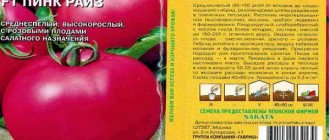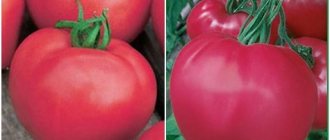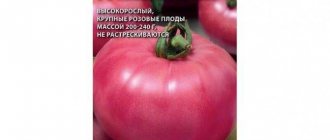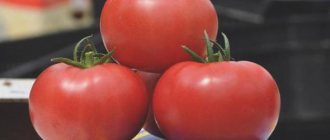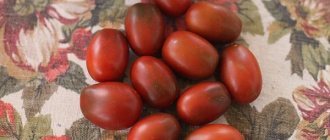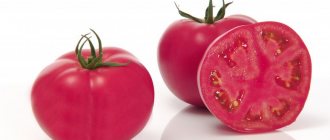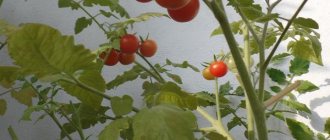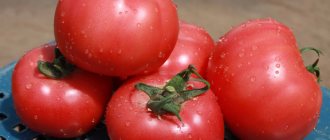An interesting new product in the planting material market from Japanese breeders is a hybrid with salad fruits and a beautiful name translated into Russian - Pink Magic. What attracted Pink Magic to summer residents and gardeners at the same time was its resistance to adverse factors and diseases, and in addition, a high yield of tasty tomatoes of excellent quality.
Description and characteristics of the variety
Tomato Pink Magic F1 (Pink Magic) is an indeterminate tall variety with excessive vegetation and long-term fruiting. During the growing period it produces up to 50 fruiting clusters.
Description of bushes:
- height 1.8-2 m or more;
- semi-spreading, branched shoots;
- the number of tomatoes per brush is from 5 to 7.
Ripening dates are early - 95-100 days from germination. Fruiting lasts until the end of September-October.
Characteristics of tomatoes:
- average weight 200-250 g;
- deep pink color;
- moderately juicy, fleshy pulp;
- strong skin;
- sugar level 4-5%;
- dry matter content 4%.
The taste is dominated by sweet notes against the background of pleasant tomato sourness and subtle tartness.
Tomatoes are used universally. Fresh fruits make aromatic, juicy salads. Add tomatoes to second and first courses. They prepare juice, ketchups, and pastes for the winter.
Description and features of the hybrid
Tall (indeterminate) hybrid tomato with powerful forced growth from the famous Japanese company Sakata. Its ripening period is mid-early and is 100-120 days from the moment of sowing the seeds and on the eve of the start of harvesting.
Tomatoes become flat-round (strongly flattened at the poles) and leveled. The hybrid produces a large percentage of uniform fruits over time. Their skin is thin, but strong and elastic. The tomatoes have a beautiful, rich pink color with a glossy sheen, giving them a degenerate charm. The fruits are very tasty, they have a good balance of sugar and acid. They are dense enough for the eyes, but with juicy flesh.
The hybrid is characterized by consistently high yields. Numerous gifts of pomona are tied in long beautiful tassels. Moreover, the bush can produce jokes and there will be a large number of brushes per season. The tomatoes are fleshy, large, with an average weight of 200-240g.
Suitable for growing in protected soil conditions (glass, polycarbonate or film greenhouses). In the southern regions, cultivation in open ground is possible, but the plant’s performance will be much lower.
Each in itself is good for the fruits of this hybrid for fresh consumption and preparation of various salads, as well as for sale in fresh vegetable markets.
Features of cultivation and storage
The hybrid variety is planted in greenhouse conditions and care is taken to maintain the optimal temperature - not lower than 23 degrees.
The hybrid is grown mainly under film. Harvests are harvested in open areas in the Krasnodar Territory and Crimea.
They are planted on the site at a distance of 50-60 cm. There should be no more than 3 bushes per 1 m2.
Subtleties of care:
- Watering with settled water at the roots, 2-3 times a week.
- Feeding at the flowering and ripening stage.
- Removing weeds and loosening, applying a mulch layer.
- Formation of bushes into 2-3 shoots and regular pinching.
The shelf life of ripened tomatoes is 1 month.
Strengths
- Fruit resistance to cracking and deformation.
- Tomatoes retain excellent commercial characteristics during long-distance transportation and long-term storage.
- Good fruit yield does not change during storage and is resistant to rotting.
- Ability to tie fruit in stressful situations, including extreme heat and drought.
- High cold resistance and shade tolerance in early spring rotation.
- Beautiful appearance of the tomatoes themselves and the fruiting bush as a whole.
- Dirt from the stalk is medium in size.
- It is highly resistant to a number of pests and diseases of nightshade crops. In particular to: verticillium and fusarium wilt, tobacco mosaic virus, brown and gray leaf spots. And as well as various types of root nematodes.
- Suitable for cultivation in winter-spring and spring-summer rotation.
Reviews from summer residents about the hybrid
- Olgusya Nikolaevna, 3 years old:
Although I am more accustomed to growing our native varieties, progress does not stand still. I purchased a packet of seeds of this variety last fall. Recommended by a salesperson at a gardening store. I would really like to try growing tall pink tomatoes in a greenhouse. But I was afraid - I thought it was very difficult... But I was afraid in vain! Pink Magic amazed me with its vitality. Even when the sun was over 40 degrees, the tomato continued to develop and bear fruit. In addition, it is literally hung with tassels with beautiful pink tomatoes. And how delicious they are! I would recommend him to summer residents on all counts. - Max, 29 years old:
What can I say? The Japanese are always great! Cool tomatoes. Delicious, beautiful, pink. And them (carriage. I sell them on the market - they go “on the fly.” I grow them in a heated greenhouse. It’s troublesome, but the result is certainly worth it.
Secrets of successfully growing a hybrid
- Sufficient daylight hours are important for the successful development of the hybrid. Therefore, cultivation in the northern regions is visible only in heated greenhouses with additional lighting.
- Picking seedlings at the stage of protruding the second leaf.
- Guaranteeing sufficient space for free growth and fruiting. It is recommended to plant 2, maximum 4 plants per square meter. meter.
- Formation of a tomato into only one trunk with regular removal of all growing stepsons and lower leaves.
- The optimal method for obtaining an early harvest is cultivation in heated greenhouses.
- Mandatory regular tying or installation of high supports. It is very important to tie the garter immediately over the top a few days after planting the seedlings in the greenhouse.
- Sowing seeds and seedlings is carried out in late February - early March.
- Planting in deserted (= sparsely populated) heated greenhouses is carried out in late April - early May.
Hybrids like this have constant growth throughout almost the entire season. To prevent excessive growth, pinching the top is necessary.
Seedlings are planted in quicksand at the age of 45-50 days.
Description of the tomato variety Pink Pioneer
Tomato Pink Pioneer from the Japanese company Sakata in Europe has long occupied its niche among hybrids bred for industrial production. In Russia, the salad variety has only recently become known. It was included in the state plant register two years ago. The new selection is equally of interest to an amateur summer resident with a greenhouse and to a farmer who grows produce for sale.
Main characteristics
The hybrid is high-yielding; in terms of fruit ripening, it is mid-early. You can expect the first ripe tomatoes 70 days after germination. The bushes are powerful, tall, and belong to the group of indeterminate type tomatoes.
An important characteristic of any variety is the taste of a ripe tomato; plum-shaped fruits have a harmonious, good taste of the pulp. The fruits are of medium size, the average weight does not exceed 200 g. The manufacturer’s stated weight is 220 g. The fruits are stored well, there are no complaints about loss of presentation during transportation.
Attitude to diseases is expressed by resistance to the following pathogens:
- nematode;
- brown spot;
- mosaic virus;
- silver leaf virus;
- wilt (verticillium, fusarium).
Description - brief instructions for caring for and growing tomatoes from Sakata contains recommendations for forming a bush. In greenhouses, tall tomatoes of the indeterminate type are recommended to be formed into one stem.
Productivity and purpose of use
During testing, the variety showed a yield of 27.6 kg/sq.m. When grown in a greenhouse and following good agricultural practices, any summer resident can achieve a similar result.
Rose fruits can be consumed raw, for making snacks and salads. The nutritional value of pink pulp increases with heat treatment, so any culinary dishes (soups, sauces) using pink fruits will be healthy. The tomato pulp is quite dense; the fruits can be used in the preparation of canned vegetables.
You can also use pink tomatoes to make tomato juice. The content of useful elements in the juice is increased; the benefits of such juice in the prevention of cancer are undeniable.
What summer residents say about the variety
The Japanese hybrid has still been little studied by Russian summer residents; there are reviews, but they are quite laconic and contradictory. Perhaps Pink Pioneer will soon be as popular as another tomato hybrid from Japan - Pink Paradise. Summer residents have already appreciated the Pink Paradise variety for its yield and sweet taste of fruits, and success will certainly come to the new hybrid Pink Pioneer.
Lyudmila, Saratov
For two seasons I grew Japanese hybrids of the first reproduction: Pablo, Pink Paradise. Used tomatoes for canning. I liked the hybrids: care is not difficult, the bushes are easy to shape, the harvest is stable. Today, in addition to these hybrids, I planted Pink Pioneer, a salad hybrid with pink fruits. I wasn’t wrong with my choice, the fruits ripened early, I won’t praise the taste to the skies, but it’s quite tomato-like. The fruits are storable and very suitable for commercial summer residents.
Anastasia, Ekaterinburg
I live in the Urals; due to weather conditions, we belong to the risky farming zone. In order to be less dependent on the vagaries of the weather, two polycarbonate greenhouses were installed on the site. There are proven varieties that I plant every year, but I don’t forget to try new ones. This season I sowed two hybrids of Japanese selection. I bought tomato seeds Pink Pioneer F1 and Pink Claire. I liked the Pink Claire hybrid better: the taste was excellent, the fruits did not crack, and there were no signs of blossom end rot. The pink tomatoes of the Pink Pioneer hybrid were inferior in taste. In all other respects, the second hybrid also suited me. I haven’t decided yet whether I will plant these varieties again, winter is ahead, I’ll still decide.
Seeds from Sakata
The Japanese company Sakata has been on the market for more than 100 years. Pink tomatoes are her profile. This is the only company in the world that has a complete range of pink tomatoes. The company offers seeds of resistant tomatoes: determinate, indeterminate, small, large, cherry, round and elliptical.
